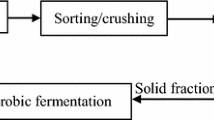Abstract
Quantitative measurements of odor emissions from biosolids were conducted relating odor units (odor intensity as perceived by people) to chemical odorant concentrations. Chemical odorant emissions from biosolids wereidentified using gas chromatography/mass spectrometry andincluded dimethyl disulfide (DMDS), dimethyl sulfide (DMS),carbon disulfide (CS2), ammonia (NH3), trimethylamine (TMA), and acetone. Odor unit emissions werepositively correlated with DMDS, DMS, CS2, NH3,TMA, and acetone emissions, demonstrating that the identifiedodorant emissions are associated with biosolids odor. To control biosolids odor, wood ash containing 32% carbon wasincorporated with biosolids at 1:1, 0.67:1, 0.33:1, and 0.11dry weight ratios. The high carbon ash additions reduced odor unit, DMDS, DMS, CS2,TMA and acetone emissions when compared to a biosolids control. Although ash addition sometimes reduced NH3 emissions, reduction was not consistently significant. Using SCREEN3 dispersion model (U.S. EPA) maximum dimethyldisulfide, NH3, and trimethyl amine concentrations from a 1 ha 21 Mg biosolids application (dry wt.) were estimated to be 29.8, 3.3, and 1.0 times higher than publishedhuman detection limits, respectively, while maximum CS2,DMS, and acetone concentrations were predicted to be 0.004, 0.01, and 0.04 times below published human detection limits, respectively. High carbon wood ash incorporation with biosolidseliminated DMDS odor and trimethyl amine odor, while wood ash did not significantly reduced the NH3 odor.
Similar content being viewed by others
References
Anon.: 1980, Reports of Studies on the Measurement of Offensive Odors (from 1972–1980), Tokyo, Japanese Environmental Agency, Code D3 (in Japanese).
Banwart, W. L. and Bremner, J. M.: 1975, Soil Biol. Biochem. 7, 359.
Bansal, R. C., Donnet, J. and Stoeckli, F.: 1988, Active Carbon, Marcel Decker Inc., New York, NY, pp. 482.
Brady, N. C. and Weil, R. R.: 1996, The Nature and Properties of Soils, Prentice Hall Inc., Upper Saddle River, New Jersey, pp. 740.
Byrne, J. F. and Marsh H.: 1995, ‘Chapter I, Introductory Overview’, in J.W. Patrick (eds.), Porosity in Carbons, Edward Arnold Publishing, London, England, pp. 18–21.
Carpenter, A. and Beecher, N.: 1997, ‘Wood Ash Finds Niche in Biosolids Composting’, Biocycle, January, pp. 37–39.
Edwards, D. D., McFeters, G. A. and Venkatesan, M. I.: 1998, Applied and Environmental Microbiology 7, 2596.
El Ammouri, G. M.: 1987, BIOCHIMIE 2, 109.
Environmental Protection Agency: 1995a, SCREEN3 Model Users Guide, U.S. Environmental Protection Agency, Research Triangle Park, North Carolina.
Environmental Protection Agency: 1995b, Industrial Source Complex (ISC3) Dispersion Model User's Guide. EPA-454/B–95–003b. U.S. Environmental Protection Agency, Research Triangle Park, NC.
Etiegni, L. and Campbell, A. G.: 1991, Bioresource Technology 37, 173.
Garcia, M. and Bacares, E.: 1997, Water Science and Technology 11–12, 197.
Gold, A. J., Lamb B. E. Loomis, G. W., Boyd. J. R. Cabelli, V. I. and McKiel C. G.: 1992, Journal of Environmental Quality 4, 720.
Harmel, R. D., Zartman, R. E., Mouron, C., Wester, D. B. and Sosebee, R. E.: 1997, Soil Sci. Soc. Am. 61, 1794.
Holdemand, L. V. and Moore, W. E. C.: 1973, Anaerobe Laboratory Manual, 2nd ed., VPI Anaerobe Lab., Virginia Polytechnic Institute and State University, Blackburg Va.
Kardos, L. T., Scarsbrook, C. E. and Volk V. V.: 1977, ‘Recycling Elements in Wastes Through Soil-Plant Systems’, in Soil for Management of Organic Waste and Waste Waters, Soil Science Society of America, Madison, Wisconsin.
Killham, K.: 1994, Soil Ecology, Cambridge University Press, Cambridge, England, pp. 42.
Martin, J. R.: 1983, BIOTECHNOL.-LETT. 2, 89.
Miller, F. C.: 1993, ‘Minimizing Odor Generation’, in H. A. J. Hoitink and H. M. Keene (eds.), Science and Engineering of Compost Design, Environmental, Microbiological and Utilization Aspects, Ohio Agriculture and Development Center, Ohio State University, Wooster, Ohio, pp. 223.
Misra, M. K., Ragland, K. W. and Baker, A. J.: 1993, Biomass and Bioenergy 2, 103.
Mosier, A. R., Morrison, S. M. and Elmond, G. K.: 1977, ‘Odors and Emissions from Organic Wastes’, in Soil for Management of Organic Waste and Waste Waters, Soil Science Society of America, Madison, Wisconsin, pp. 532–569.
Muse, J. K. and C. C. Mitchell.: 1995, Agronomy Journal 87, 432.
Pichtel, J. R. and Hayes, J. M.: 1989, J. Environ. Qual. 19, 593.
Ruth, J. H.: 1986, Am. Ind. Hyg. Assoc. J. 47, 142.
Rosenfeld, P. E.: 1999, ‘Characterization, Quantification and Control of Odor Emissions from Biosolids Application to Forest Soil’, Ph.D. Dissertation, University of Washington, pp. 154.
Schade, G. W. and Crutzen, P. J.: 1995, Journal of Atmospheric Chemistry 22, 319.
Sommers, L. E., Tabatabai, M. A. and Wilson, D. W.: 1977, J. Environ. Qual. 1, 42.
Sunesson, A. L., Vaes, W. A. J., Nilsson, C. A., Blomquist, G, Andersson, B. and Carlson, R.: 1995, Applied Environmental Microbiology 8, 2911.
Tkach, N. Z.: 1965, Hyg. Sanit. USSR 30, 179.
Tipler, C. J. M.: 1995, ‘Odour and Its Measurement’, in Prodeedings of the Technical Session #12, Aerosols and Odours from Land Treatment Systems, April 27–28 1995, New Zealand Land Treatment Collective, Lincoln University, Canterbury.
Wong, M. H. and Wong J. W. C.: 1986, Environmental Pollution 40, 127.
Author information
Authors and Affiliations
Rights and permissions
About this article
Cite this article
Rosenfeld, P.E. Effect of High Carbon Ash on Biosolids Odor Emissions and Microbial Activity. Water, Air, & Soil Pollution 131, 245–260 (2001). https://doi.org/10.1023/A:1011975732056
Issue Date:
DOI: https://doi.org/10.1023/A:1011975732056




